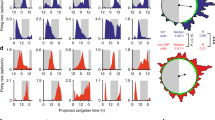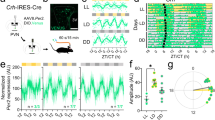Abstract
CELLULAR secretions from either exocrine or endocrine glands are regulated in most cases by hormonal or neurohormonal agents. These chemical messengers interact with cellular receptors to stimulate a particular secretory response. In general, it would seem that changes in the transmembrane electrical potential of the secretory unit is in some way intimately involved in this stimulus–secretion coupling1. Here we provide evidence of cellular secretion resulting from spontaneous electrical activity (most probably depolarisations) after removal of a previously inhibitory stimulus.
This is a preview of subscription content, access via your institution
Access options
Subscribe to this journal
Receive 51 print issues and online access
$199.00 per year
only $3.90 per issue
Buy this article
- Purchase on Springer Link
- Instant access to full article PDF
Prices may be subject to local taxes which are calculated during checkout
Similar content being viewed by others
References
Matthews, E. K., in Secretory Mechanisms of Exocrine Glands (edit. by Thorn, N. A., and Paterson, O. H.), 185–198 (Academic Press, New York, 1974).
Hadley, M. E., and Bagnara, J. T., Am. Zool., 15, 81–104 (1975).
Bagnara, J. T., and Hadley, M. E., Chromatophores and Color Change: the Comparative Physiology of Animal Pigmentation (Prentice-Hall, Englewood Cliffs, New Jersey, 1973).
Etkin, W., Gen. comp. Endocr. Suppl., 1, 148–159 (1962).
Parsons, J. A., J. Physiol, Lond., 210, 973–987 (1970).
Hadley, M. E., Bower, Sr. A., and Hruby, V. J., Yale J. Biol. Med., 46, 602–616 (1973).
Dierst-Davies, K., Ralph, C. L., and Pechersky, J. L., Gen. comp. Endocr., 6, 409–419 (1966).
Dawson, D. C., and Ralph, C. L., Neuroendocrinology, 15, 267–280 (1974).
Enemar, A., and Falck, B., Gen. comp. Endocr., 5, 577–583 (1965).
Hopkins, C. R., Gen. comp. Endocr., 16, 112–120 (1971).
Nakai, Y., and Gorbman, A., Gen. comp. Endocr., 13, 108–116 (1969).
Iturriza, F. C., and Kasal-Iturriza, M., Gen. comp. Endocr. Suppl., 3, 108–113 (1972).
Bower, A., Hadley, M. E., and Hruby, V. J., Science, 184, 70–72 (1974).
Oshima, K., and Gorbman, A., Gen. comp. Endocr., 13, 98–107 (1969).
Huntington, T., and Hadley, M. E., Endocrinology, 96, 472–479 (1974).
Author information
Authors and Affiliations
Rights and permissions
About this article
Cite this article
DUFF DAVIS, M., HADLEY, M. Spontaneous electrical potentials and pituitary hormone (MSH) secretion. Nature 261, 422–423 (1976). https://doi.org/10.1038/261422a0
Received:
Accepted:
Issue Date:
DOI: https://doi.org/10.1038/261422a0
This article is cited by
-
Dopamine D2 receptor stimulation alters G-protein expression in rat pituitary intermediate lobe melanotropes
Endocrine (1997)
-
GFAP expression induced by dopamine D2 receptor agonists in the rat pituitary intermediate lobe
Endocrine (1996)
-
Action potentials in non-tumor cells from the anterior pituitary gland
Experientia (1978)
-
Sodium and calcium action potential in pituitary cells
Nature (1977)
Comments
By submitting a comment you agree to abide by our Terms and Community Guidelines. If you find something abusive or that does not comply with our terms or guidelines please flag it as inappropriate.



